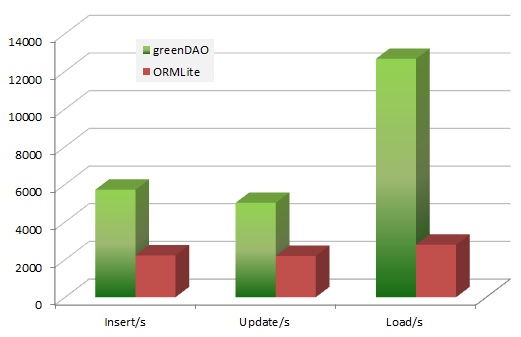If you are developing an Android application, you will likely need to store data somewhere. You may choose a Cloud service (in which case, using a SyncAdapter would be a good idea), or to store your data in the embedded SQLite database. If you take the second option, you will have to decide between writing SQL queries, using a Content Provider (useful if you want to share your data with other apps), or using an ORM.
In this article, I will discuss some of the Android ORMs you may consider using in your application.
OrmLite
OrmLite is the first Android ORM that comes to my mind. However OrmLite is not an Android ORM, it’s a Java ORM with SQL databases support. It can be used anywhere Java is used, such as JDBC connections, Spring, and also Android.
It makes heavy usage of annotations, such as @DatabaseTable for each class that defines a table, or@DatabaseField for each field in the class.
A simple example of using OrmLite to define a table would be something like this:
|
1
2
3
4
5
6
7
8
9
10
11
12
13
14
15
16
17
18
19
20
21
22
23
24
25
26
27
28
29
|
@DatabaseTable(tableName = "users")public class User { @DatabaseField(id = true) private String username; @DatabaseField private String password; public User() { // ORMLite needs a no-arg constructor } public User(String username, String password) { this.username = username; this.password = password; } // Implementing getter and setter methods public String getUserame() { return this.username; } public void setName(String username) { this.username = username; } public String getPassword() { return this.password; } public void setPassword(String password) { this.password = password; }} |
OrmLite for Android is open source and you can find it on GitHub. For more information read its official documentation here.
SugarORM
SugarORM is an ORM built only for Android. It comes with an API which is both simple to learn and simple to remember. It creates necessary tables itself, gives you a simple methods of creating one-to-one and one-to-many relationships, and also simplifies CRUD by using only 3 functions, save(), delete() and find()(or findById()).
Configure your application to use SugarORM by adding these four meta-data tags to your appsAndroidManifest.xml:
|
1
2
3
4
|
<meta-data android:name="DATABASE" android:value="my_database.db" /><meta-data android:name="VERSION" android:value="1" /><meta-data android:name="QUERY_LOG" android:value="true" /><meta-data android:name="DOMAIN_PACKAGE_NAME" android:value="com.my-domain" /> |
Now you may use this ORM by extending it in the classes you need to make into tables, like this:
|
1
2
3
4
5
6
7
8
9
10
11
12
13
14
15
|
public class User extends SugarRecord<User> { String username; String password; int age; @Ignore String bio; //this will be ignored by SugarORM public User() { } public User(String username, String password,int age){ this.username = username; this.password = password; this.age = age; }} |
So adding a new user would be:
|
1
2
|
User johndoe = new User(getContext(),"john.doe","secret",19);johndoe.save(); //stores the new user into the database |
Deleting all the users of age 19 would be:
|
1
2
3
4
|
List<User> nineteens = User.find(User.class,"age = ?",new int[]{19});foreach(user in nineteens) { user.delete();} |
For more, read SugarORM’s online documentation.
GreenDAO
When it comes to performance, ‘fast’ and GreenDAO are synonymous. As stated on its website, “most entities can be inserted, updated and loaded at rates of several thousand entities per second”. If it wasn’t that good,these apps wouldn’t be using it. Compared to OrmLite, it is almost 4.5 times faster.

greenDAO vs OrmLite
Speaking of size, it is smaller than 100kb, so doesn’t affect APK size very much.
Follow this tutorial, which uses Android Studio to show the usage of GreenDAO in an Android application. You can view the GreenDAO source code on GitHub, and read the GreenDAO official documentation.
Active Android
Much like other ORMs, ActiveAndroid helps you store and retrieve records from SQLite without writing SQL queries.
Including ActiveAndroid in your project involves adding a jar file into the /libs folder of your Android project. As stated in the Getting started guide, you can clone the source code from GitHub and compile it using Maven. After including it, you should add these meta-data tags into your app’sAndroidManifest.xml:
|
1
2
|
<meta-data android:name="AA_DB_NAME" android:value="my_database.db" /><meta-data android:name="AA_DB_VERSION" android:value="1" /> |
After adding these tags, you can call ActiveAndroid.initialize() in your activity like this:
|
1
2
3
4
5
6
7
8
9
|
public class MyActivity extends Activity { @Override public void onCreate(Bundle savedInstanceState) { super.onCreate(savedInstanceState); ActiveAndroid.initialize(this); //rest of the app }} |
Now that the application is configured to use ActiveAndroid, you may create Models as Java classes by usingAnnotations:
|
1
2
3
4
5
6
7
8
9
10
11
12
13
14
15
16
17
18
|
@Table(name = "User")public class User extends Model { @Column(name = "username") public String username; @Column(name = "password") public String password; public User() { super(); } public User(String username,String password) { super(); this.username = username; this.password = password; }} |
This is a simple example of ActiveAndroid usage. The documentation will help you understand the usage of ActiveAndroid ORM further.
Realm
Finally Realm is a ‘yet-to-come’ ORM for Android which currently only exists. It is built on C++, and runs directly on your hardware (not interpreted) which makes it really fast. The code for iOS is open source, and you can find it on GitHub.
On the website you will find some use cases of Realm in both Objective-C and Swift, and also a Registration form to get the latest news for the Android version.
Final words
These are not the only Android ORMs on the market. Other examples are Androrm and ORMDroid.
SQL knowledge is a skill that every developer should have, but writing SQL queries is boring, especially when there are so many ORMs out there. When they make your job simpler, why not use them in the first place?
How about you? What Android ORM do you use? Comment your choice below